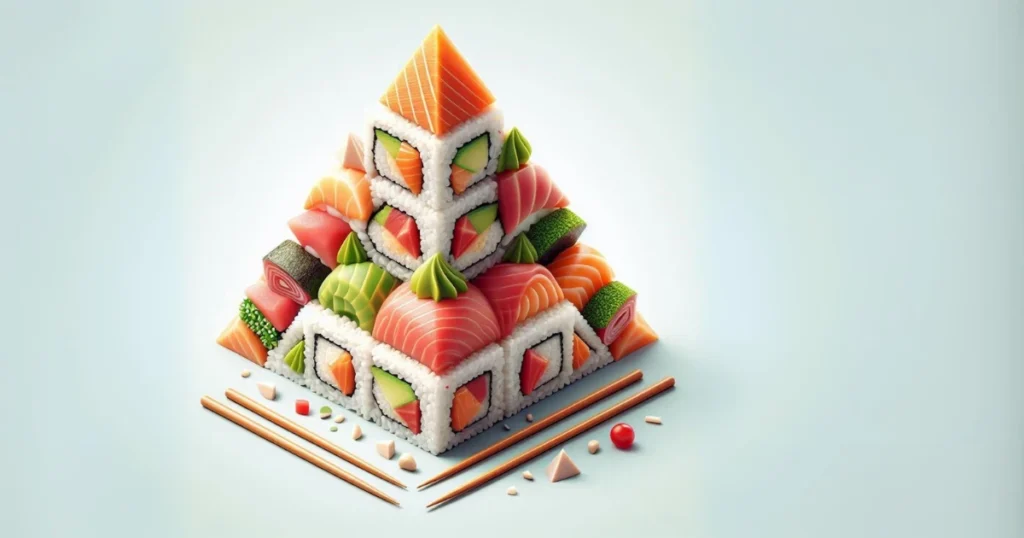
Triangle sushi is a triangle-shaped rice ball, also called an onigiri. Onigiri can be in various shapes, but triangle-shaped onigiri are the most popular.
You can eat this famous Japanese dish cold or pan-fried, with or without toppings. You can use it in many ways, making it a great snack or lunchbox food.
It contains a significant amount of iodine and, depending on the fillings, a variety of other beneficial nutrients.
That’s all I have to say about triangle sushi: what it is, how to make it, how it might be good for you, and what you should know if you want to start eating it.
What is triangle sushi?
Triangle sushi, as its name suggests, is sushi in the shape of a triangle. We wrap nori, a type of edible dried seaweed, around steamed sushi rice to make it.
At its most basic level, a triangle sushi consists of just rice and seaweed. You can, however, add things like fish, tofu, beans, fruit, or veggies to fill it up.
According to a story, some people think that making the rice balls look like mountains was originally a way for Japanese people to ask for protection from ghosts.
Others think that the triangle shape was chosen because it takes up less room and is easier to pack and carry than the three other most common shapes, which are disc, round, and pillar.
Triangle sushi differs from other sushi rolls primarily due to the seasoning of the rice with sugar and rice vinegar. On the other hand, when making triangle sushi, you don’t add any sugar or rice vinegar to the heated rice.
Some people prefer to season the rice with things like furikake to make it taste better.
Fish, dried seaweed (nori), sesame seeds, salt, and spices combine to create the Japanese flavor furikake. It may also have eggs and sugar in it sometimes.
Some traditional triangle sushi toppings are pickled plum, salted salmon, tuna in mayonnaise, kombu, or dried fish with soy sauce.
However, vegans can use a variety of foods, including tofu, beans, fruit, vegetables, and fresh seaweed.
Nutritional profile
All you need to make the most basic triangle sushi is cooked and dried sushi rice. Each triangle weighs approximately 1.4 ounces (41 grammes) and serves approximately
- Calories: 49 kcal
- Protein: 1 gram
- Carbohydrates: 11 grams
- Sugar: < 1 gram
- Fiber: < 1 gram
- Fat: < 1 gram
- Iodine: 23%
- Copper: 9% DV
- Selenium: 5% DV
- Zinc: 3% DV
- Magnesium: 3% DV
- Thiamin: 3% DV
- Iron: 2%
- Riboflavin: 2%
- Niacin: 2% DV
When you add things to sushi rice, it changes how healthy it is. For example, adding fish, tofu, or beans will increase the amount of protein, iron, and zinc. Adding fruit or vegetables will increase the amount of potassium and vitamins A and C.
Triangle sushi can have a lot of salt if you add things like soy sauce, pickled plum, or furikake to it, so it’s best to be careful or choose low-sodium versions when you can.
Benefits and downsides
You might be able to get some health benefits from eating triangle sushi. You should also think about a few other things.
Support thyroid function
People roll triangle sushi on a sheet of dried seaweed, believed to be a good source of the mineral iodine.
Iodine is very important for keeping your thyroid healthy. The thyroid regulates metabolism and other functions.
Eating too little iodine may affect your thyroid. This can lead to signs like dry skin, low energy, forgetfulness, depression, weight gain, and tingling in your hands and feet.
150 mcg of iodine a day is the amount that people should get. A triangle of sushi, rolled in a half-sheet of nori, contains about 35 mcg of iodine, or 23% of the daily value (DV).
Promote gut health
It might benefit your digestive system. Because triangle sushi contains seaweed, it also contains agars, fucoidans, and carrageenans, all of which are prebiotic chemicals.
Prebiotics are fibers that your body can’t break down. They feed the good bugs that line your gut. When there are more good bacteria in your gut, there is less room for bad bacteria. Having that balance in your gut is good for you.
Prebiotics may help your immune system, brain, and heart health in addition to keeping your gut healthy.
Researchers also think seaweed prebiotics may be antibacterial and anti-inflammatory, improving your health.
Contain heavy metals
If your triangle sushi contains fish, shrimp, or seaweed, heavy metals like arsenic or mercury may enter it by accident.
How much heavy metal is in fish varies depending on the type of fish and how polluted the water is where the fish and adults live.
Recent studies found that mercury levels in about one-third of the fish samples they looked at were higher than the safe standards set by the World Health Organisation.
Many health issues, including headaches, dementia, tremors, loose teeth, and fatigue, have been associated with heavy metals like mercury.
Mercury is usually higher in larger, older fish. Shark, swordfish, king mackerel, bluefish, bluefin tuna, and striped bass are some of the fish that have the most.
Chemicals such as arsenic and heavy metals can also be found in seaweed. The amount will depend on how polluted the area where the seaweed grew is, just like with fish.
Although most seaweed doesn’t appear to contain more arsenic than is safe,
A normal serving of triangle sushi also doesn’t have a lot of seaweed in it, so there isn’t much chance that you’ll get too much arsenic.
However, people who eat a lot of seaweed every day, such as sushi, seaweed salad, or vitamins made from seaweed, may want to keep this risk in mind.
Contains a lot of salt.
Triangle sushi can have a lot of sodium (salt), especially if you add salty sauces like soy sauce and coconut aminos to make it taste better.
If they eat too much salt, some people may have higher blood pressure, which can raise their risk of heart failure.
People who eat a lot of salt may also be more likely to get stomach cancer. However, we need to do more research to fully understand how this link works in people.
If you want to lower the amount of salt in your triangle sushi, choose seasonings and sauces that are low in sodium.


